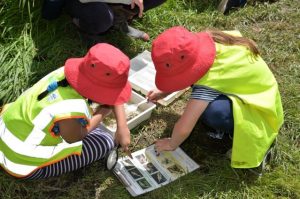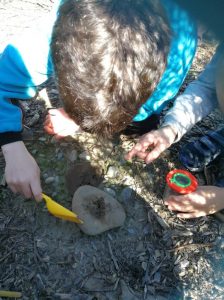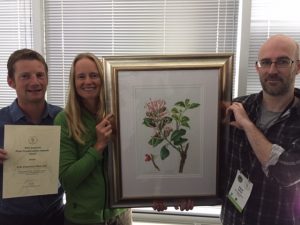By working together and streamlining existing projects, Te Ara Kākāriki and Enviroschools Canterbury have made it easier for schools to incorporate conservation and biodiversity into their curriculum through the Kids Discovery Plant-out programme.
The power of collaboration
The Kids Discovery Plant-out (KDP) programme is a successful collaboration between Te Ara Kākāriki and Enviroschools that has been delivered to Selwyn schools for the past six years. The aim of the KDP programme is to connect students to their place and spark curiosity by leading restoration planting through learning about the inter-connectedness of a native ecosystem and its different values.
Students have the opportunity to learn about native biodiversity through hands-on experience, by adopting a long-term relationship with a native ecosystem close to their school. Through planting and monitoring days, the students take on a role of tiaki tamariki, caring for their special biodiversity restoration site and together contributing to restoring native ecosystems across the Canterbury Plains.
Integrating action into the curriculum
Enviroschools aims to support integration of sustainable practice throughout the school curriculum. This intention is achieved within the KDP programme as student-led action to restore habitat is carried out within the context of a whole school inquiry focus. In 2019, the majority of teachers shared their sustainability goals with Matt Stanford, their Enviroschools Facilitator, allowing him to create a bespoke programme of hands-on activities that supported their curriculum focus.
The Enviroschools Canterbury Facilitator works with the school prior to the day to ensure the plant-out day is a part of the school’s formal curriculum. The KDP programme is not just another planting day for students; each Kids Discovery Plant-out is unique.

Students careful identify species inhabiting their awa.
The day always puts the restoration planting into a larger context, often focusing around issues that threaten or diminish biodiversity values, water quality, and associated solutions. This has meant up to 160 students rotate around activities that include identifying plants and their values, germinating eco-sourced seeds, propagating cuttings, stream invertebrate monitoring to indicate waterway health, learning of the importance of riparian planting for improving water quality, birds and seed dispersal, weaving and hearing pūrākau (stories) of the significance of the area with kairaranga (weavers) from Taumutu, and making mini-wave barriers like that of the NIWA Te Waihora/Lake Ellesmere project as they try to restore the macrophyte beds.
A scientifically robust monitoring regime with Lincoln University has also been developed through the programme. This includes photo-points for vegetation monitoring and percentage survival rates. This is led by the students and the results are entered into iNaturalist citizen science records. The monitoring indicates that the average percentage survival in the 2018 planting season was excellent, at 93.3%.

Students closely inspect terrestrial invertebrate life.
Some highlights for the students include learning bird calls for identification of birds that have moved into the planting area, and looking under wooden discs for invertebrate tenants! Some schools have been involved in the restoration of their special site for five years now and the relationship has thus deepened into that of an ‘outdoor classroom’. They are now collecting local native seeds to grow and are planting and harvesting their own harakeke for raranga/weaving.
“I liked getting my hands dirty and doing something practical to really help the environment. I can come back when I’m older and explore a forest that I helped to plant. That’s pretty cool.” Vana, age 11
This year, one school’s curriculum focus was food so we used their school forest to connect them to rongoā and food values of the native plants. Children harvested and brewed kānuka tea before creating packaging to market the tea as part of their persuasive writing work. They may also use their ‘outdoor classroom’ to take part in the annual garden bird survey or run an environmental clean-up.
Tackling a deeper issue
The motivation behind the creation of Kids Discovery Plant-out is the fact that there is less than 1% of indigenous vegetation left on the Canterbury plains; this fact is gently reinforced at every KDP planting day or monitoring session.
Students are transported back in time through story-telling and hands-on experiences to learn about a time before humans when the bird song was deafening. They are taught about a time when early Māori used Mokihi to navigate the awa, like we now use roads, and foraged for mahinga kai species. They are then brought right up to modern times and the change in land use and associated issues. The students are encouraged to ponder why and share a vision for the future.
The fact that only 1% of native vegetation remains give these young people a 99% opportunity for restoration action – they are not burdened with negativity but enabled to act and to help build an environmentally, culturally, and socially sustainable future in Selwyn.
Since its inception six years ago the programme has grown to now engage 15 Selwyn schools, with over 10,000 plants nurtured by tamariki. The future is looking bright for restoration learning and action in Selwyn, and the plan is to further increase the learning opportunities for young people by developing propagation units. These will help students plan, design, and learn about native plant growing and care, and contribute to restoration around the district (as has been successfully modelled by Enviroschools in the Wai Nursery project in Northland).
“We’ve planted 1200 trees at the site now and I feel so proud, I’m doing something for the world, not just for me, or the school, it feels like I’m making a real difference.”
Freddie, age 10
Nationwide recognition for student and group
 KDP and Springston School, Kura o Makonui student Tody Benison was selected as this year’s winner of the NZPCN award in recognition of their commitment to effective restoration.
KDP and Springston School, Kura o Makonui student Tody Benison was selected as this year’s winner of the NZPCN award in recognition of their commitment to effective restoration.
Dr Catherine Beard, NZPCN Awards convenor remarked that she was really impressed with the KDP programme which gets so many students up close and personal with New Zealand’s native flora and hands-on experience of restoring native ecosystems.
For more detailed information about this success story read KDP annual report here. Kids Discovery Plant-out Annual Report 2019
Banner Photo: Lincoln Primary School tamariki and DoC staff get stuck in to planting as part of the Billion Trees Programme on the shores of Te Waihora. Lake Ellesmere, Selwyn, Canterbury.
